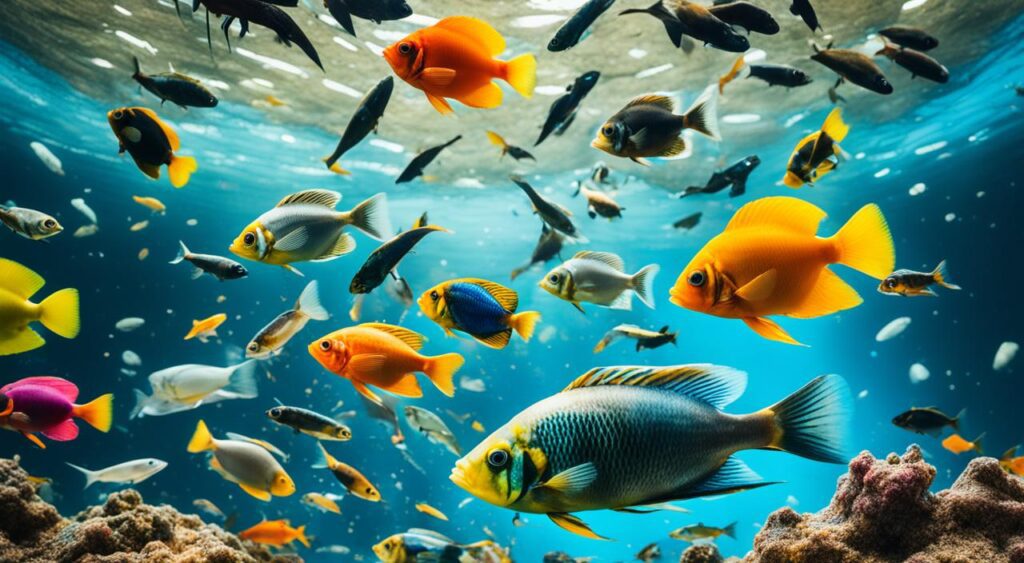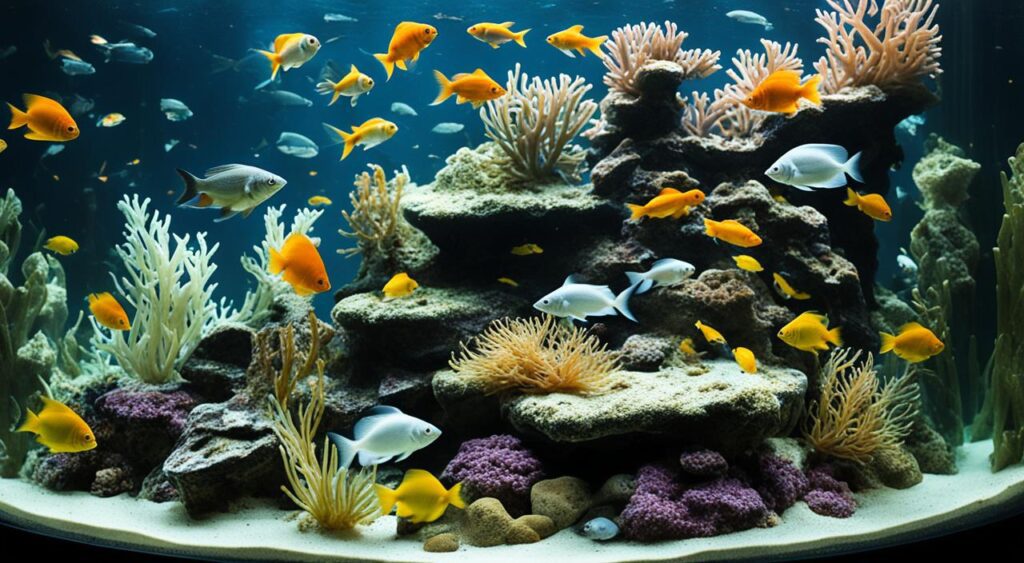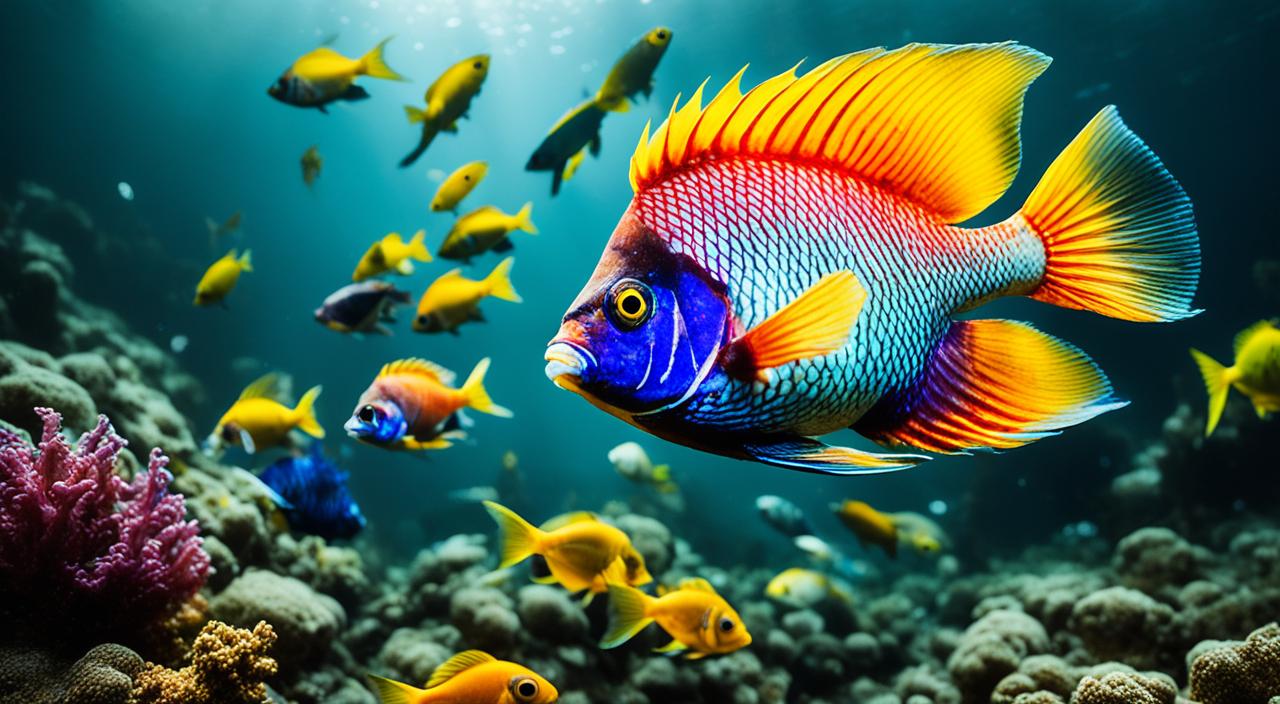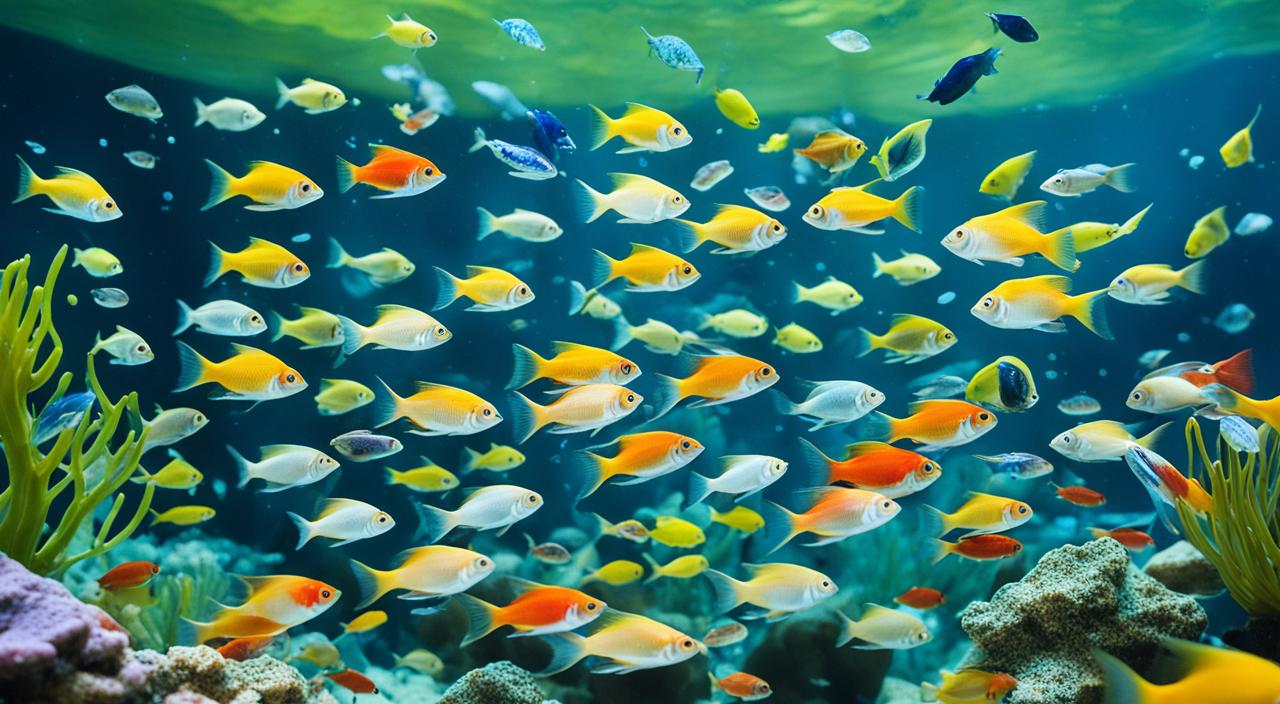As aquarium enthusiasts, we love the vibrant colours and graceful movements of the fish that adorn our tanks. However, behind the glass, a troubling reality looms – many aquarium fish species face extinction. The disappearance of these beautiful creatures is a cause for concern, and we must understand the reasons behind their endangerment to take action.
The allure of aquarium fish has led to their increased demand in the pet trade industry. Unfortunately, this growing demand is taking a toll on their populations. Factors such as habitat destruction, overfishing, and the degradation of their natural habitats all contribute to the rapid decline in numbers. It’s time to illuminate the disappearing fish and address their challenges.
Key Takeaways:
- The demand for aquarium fish is causing a decline in their populations.
- Habitat destruction, overfishing, and habitat degradation are the main reasons for fish endangerment.
- We must address the challenges aquarium fish face to ensure their survival.
- Conservation efforts are crucial to protect and preserve endangered fish species.
- Public awareness and sustainable practices are essential to supporting fish conservation.
The Vital Role of Aquarium Ecosystems
Aquariums are not just a source of entertainment; they play a vital role in conservation efforts. They provide a controlled environment for fish to thrive and reproduce, contributing to preserving endangered species. Furthermore, the education and awareness generated by aquariums can help raise public support for fish conservation.
With their carefully maintained ecosystems, aquariums create a safe haven for fish species facing numerous wild threats. These controlled environments offer a sanctuary where fish can live and reproduce without the pressures of predation, habitat degradation, or competition for resources. By simulating natural habitats, aquariums help maintain healthy fish populations, including endangered or at risk.
Moreover, aquariums serve as platforms for educating the public about the importance of conservation and the interdependence of ecosystems. Aquarium visitors gain valuable insights into aquatic species’ diversity, habitats, and challenges. This firsthand experience fosters a deeper understanding of the fragile balance in aquatic ecosystems and highlights the urgent need for action to protect fish in their natural habitats.
Through exhibits, interactive displays, and educational programs, aquariums inspire individuals to become advocates for fish conservation. By learning about the interconnectedness of aquatic life and the impact of human activities on these ecosystems, visitors are motivated to make environmentally conscious choices. These choices include supporting sustainable fishing practices, reducing pollution, and promoting responsible pet ownership.
Aquariums also play a crucial role in species preservation through conservation breeding programs. These programs strive to breed and reintroduce endangered fish species back into their natural habitats, helping to bolster wild populations. The knowledge gained through these breeding programs contributes to scientific research and enhances our understanding of fish biology, behaviour, and ecological requirements.
In conclusion, aquariums are not just recreational attractions; they are essential tools for fish conservation and environmental education. By providing a controlled environment for fish to thrive and by raising public awareness of the importance of fish conservation, aquariums contribute significantly to the preservation of endangered species and the sustainability of aquatic ecosystems.
Threatened Fish Populations in the American Southeast
The American Southeast is home to many freshwater fish species, many of which are threatened. The construction of dams and the pollution of their habitats pose significant challenges to these populations. Recently, there has been a growing concern about the decline in freshwater fish diversity and the urgent need for conservation efforts.
The Tale of Never-Ending Dams and Pollutants
Dams have been constructed extensively throughout the American Southeast for various purposes, such as flood control, electricity generation, and water supply. While these dams serve essential functions, they also harm fish populations. Dams obstruct the natural flow of rivers, creating barriers that hinder fish migration and disrupt their reproductive patterns. These disruptions often lead to declining fish populations, as they cannot access suitable breeding grounds.
The pollution of freshwater habitats is another significant threat to fish populations in the American Southeast. Runoff from agricultural activities, industrial processes, and urban areas introduces pollutants into rivers and streams, harming aquatic ecosystems. Pollutants such as chemicals, sediment, and excess nutrients can harm fish health and reproduction. They can also cause changes in water quality, affecting the availability of food and shelter for fish.
Testimony of Conservation Fisheries, Inc.
One organization at the forefront of protecting and restoring threatened fish populations in the American Southeast is Conservation Fisheries, Inc. Founded in 1986, this non-profit organization conserves native fish species through research, propagation, and habitat restoration.
Conservation Fisheries, Inc., has been instrumental in recovering several imperilled fish species in the region. By partnering with government agencies, universities, and other conservation organizations, it has successfully implemented strategies to restore populations of fish species such as the Smoky Madtom and the Blackside Dace.
The Mysterious Beauty of Freshwater Fish
The unique beauty of freshwater fish adds to the urgency of conservation efforts. These fish species exhibit a remarkable array of colours, patterns, and behaviours that make them captivating to observe. From the vibrant hues of tropical fish to the elegant camouflage of native species, each freshwater fish has its irresistible charm.
Preserving the diversity of freshwater fish is crucial for the health of aquatic ecosystems and the cultural and aesthetic value they bring to our lives. As threatened fish populations decline, we risk losing the enchanting beauty and diversity these creatures bring to our rivers, lakes, and aquariums.
Fish that We Find in Our Aquariums and the Reasons Why in Danger of Disappearing

Many fish species commonly found in aquariums are at risk of disappearing. These popular aquarium fish face numerous endangerment factors, including overfishing for the ornamental fish trade and habitat loss.
The demand for these beautiful and captivating fish species, such as the vibrant Neon Tetras, mesmerizing Angelfish, and charismatic Clownfish, has led to unsustainable fishing practices. Overfishing to meet the high demand in the aquarium industry has put immense pressure on wild populations. This overexploitation threatens these fish’s survival and disrupts the delicate balance of their natural habitats.
Another significant factor contributing to the endangerment of aquarium fish is habitat loss. Human activities, such as deforestation, pollution, and urbanization, have destroyed and degraded their natural habitats. The destruction of vital ecosystems like coral reefs, which provide shelter, protection, and food for many fish species, has a devastating impact on their survival.
To illustrate the severity of these endangerment factors, consider the impact of overfishing on species like the colorful Dossi fish. Lightweight and easily caught, Dossi fish have become a favorite among fish enthusiasts, leading to excessive harvesting from their natural habitats. Similarly, destroying coral reefs, home to popular aquarium fish like the vibrant Mandarin fish, has left these species extremely vulnerable.
Unsustainable Practices in the Aquarium Trade

The aquarium trade plays a significant role in endangering fish species through unsustainable practices. One of the most pressing issues is overfishing, driven by the demand for rare and exotic species in ornamental fish markets. This relentless pursuit of unique aquatic species puts immense pressure on wild populations, leading to their decline and possible extinction.
Overfishing for Ornamental Fish Markets
Overfishing involves intensive fish capture from their natural habitats for trade in the aquarium industry. The desire to acquire rare and visually appealing species drives collectors and traders to exploit local and international waters, often without considering the long-term consequences. As a result, fish populations are dwindling, compromising the delicate ecological balance of aquatic ecosystems.
The overfishing of certain species has severe ramifications for their survival. These species often have slow reproductive rates and limited distribution, making them particularly vulnerable to exploitation. These fish face a bleak future without strict regulations and sustainable fishing practices.
Harsh Realities Behind the Glass Tanks
The unsustainability of the aquarium trade is not limited to overfishing alone. The conditions within aquariums themselves contribute to the decline of fish populations. Many aquariums operate under poor conditions and lack proper care, leading to stress, disease outbreaks, and sometimes death among the captive fish. These harsh realities behind the glass tanks further exacerbate the already dire situation for many species.
Acknowledging the negative environmental impact of the aquarium trade and working towards implementing sustainable practices is essential. By prioritizing the well-being of fish and their natural habitats, we can ensure the long-term survival of these remarkable aquatic creatures.
Habitat Loss for Fish: A Global Crisis
Habitat loss is a global crisis that poses a significant threat to fish populations worldwide. The destruction of natural habitats due to agriculture and urbanization has displaced and declined numerous fish species. Additionally, the degradation of coral reefs, which serve as critical habitats for many aquarium fish, further exacerbates the crisis.
Destruction of Natural Habitats for Agriculture and Urbanisation
The expansion of agriculture and urban areas has destroyed fish habitats. Deforestation, land clearing, and the conversion of natural ecosystems into farmlands and urban developments have significantly reduced the availability of suitable habitats for fish. This habitat loss disrupts the ecological balance and leads to the displacement and decline of fish populations.
“The destruction of natural habitats for agricultural and urban purposes has devastating consequences for fish species. As we continue to encroach upon their homes, we jeopardize their survival and contribute to a global crisis of fish habitat loss.”
Sustainable land-use practices and urban planning strategies need to be implemented to mitigate the habitat loss caused by agriculture and urbanization. Conservation efforts should focus on preserving and restoring natural habitats, providing corridors for fish migration, and minimizing the impacts of human activities on aquatic ecosystems.
The Bleak Future of Coral Reefs and What It Means for Aquarium Species
Coral reefs are among the world’s most diverse and vibrant ecosystems, supporting many fish species. However, coral reef degradation is a significant concern for the aquarium industry and fish conservation. Factors such as coral bleaching, ocean acidification, pollution, and overfishing contribute to the decline of coral reefs, resulting in the loss of habitat for many aquarium fish species.
The deterioration of coral reefs affects the survival of aquarium fish species and has broader ecological consequences. Coral reefs provide essential shelter, breeding grounds, and food sources for numerous marine organisms. The loss of these habitats disrupts the delicate balance of marine ecosystems and puts entire fish populations at risk.
Concerted global efforts are needed to reduce carbon emissions, implement sustainable fishing practices, and establish marine protected areas to address the crisis of coral reef degradation. Conservation initiatives should focus on restoring damaged reefs, promoting coral reef resilience, and raising public awareness about the vital importance of these ecosystems.
Advances in Fish Conservation and Rehabilitation
Despite the challenges facing fish populations, there is hope on the horizon. Thanks to the dedicated efforts of conservation organizations and research institutions, significant advancements have been made in fish conservation and rehabilitation. These initiatives aim to protect endangered species and restore their populations to healthier levels.
Conservation organizations play a crucial role in fish conservation efforts. They work tirelessly to identify and address the critical threats facing fish populations, such as habitat loss, overfishing, and pollution. These organizations collaborate with stakeholders, governments, and local communities to implement effective strategies promoting fish species’ recovery and sustainability.
Research institutions contribute to species rehabilitation through their scientific expertise and innovative approaches. By conducting various studies and experiments, they gain a deeper understanding of fish biology, behavior, and the ecological factors that impact their survival. This knowledge allows them to develop targeted conservation plans and implement effective management practices to conserve fish populations.
One of the success stories in fish conservation is the recovery of the European Atlantic sturgeon population. Once driven to the brink of extinction due to overfishing and habitat degradation, targeted conservation efforts have significantly increased their numbers. Implementing strict fishing regulations, habitat restoration projects, and captive breeding programs has played a vital role in their recovery.
Another remarkable success story is the rehabilitation of the Kemp’s ridley sea turtle. This endangered species faced multiple threats, including habitat loss, nesting site disturbance, and accidental capture in fishing gear. Through collaborative efforts, including protecting nesting beaches and adopting turtle excluder devices in fishing gear, Kemp’s ridley sea turtle population has rebounded, giving hope to the conservation of other marine species.
Innovative approaches, such as aquaculture techniques, have also shown promise in fish conservation. In captive breeding programs, endangered fish species are bred under controlled conditions to reintroduce them into the wild. This approach helps to increase population sizes and genetic diversity, ultimately contributing to the long-term survival of these species.
Overall, fish conservation efforts and species rehabilitation significantly impact protecting and restoring endangered fish populations. By leveraging scientific knowledge, collaboration, and innovative strategies, we can continue to achieve conservation success stories. However, we must maintain our efforts and raise public awareness about the importance of fish conservation to ensure a sustainable future for these remarkable creatures.
Conclusion
The disappearance of fish species commonly found in our aquariums is a stark reminder of the urgent need for fish conservation efforts. We must raise public awareness about the importance of protecting these species and promote sustainable practices in the aquarium trade.
By working together, we can ensure the survival of aquarium fish for future generations to enjoy. Public awareness plays a vital role in supporting conservation initiatives. Through education and understanding, we can inspire individuals to take action and make a difference in the preservation of these beautiful creatures.
Furthermore, adopting sustainable practices in the aquarium trade is essential for the long-term well-being of fish populations. This includes sourcing fish from responsible breeders and suppliers, promoting captive breeding programs, and ensuring proper care and maintenance of aquariums. By prioritizing the welfare of fish and their natural habitats, we can minimize negative impacts and contribute to their conservation.
Ultimately, the future of aquarium fish relies on our collective efforts to protect and preserve these fascinating species. Let us work together to raise public awareness, encourage sustainable practices, and ensure a thriving future for these extraordinary creatures that bring beauty and joy to our lives.


